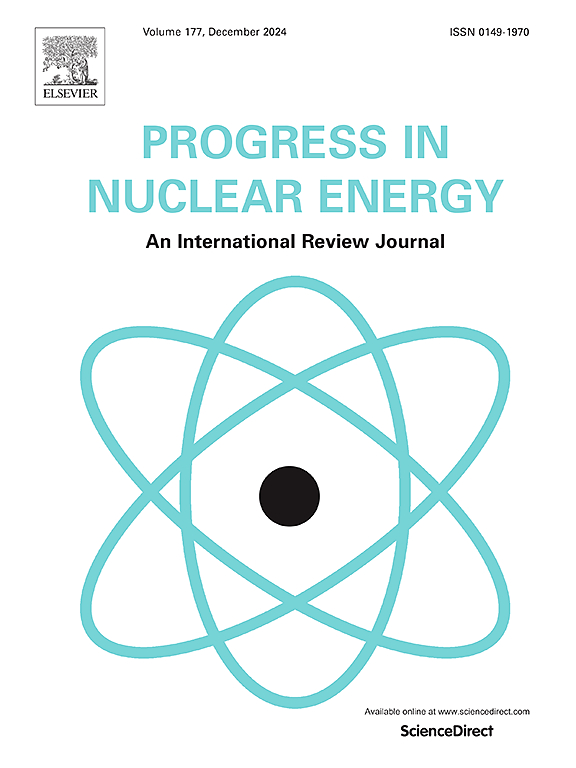Experimental study on characteristics of phase distribution in air-water bubbly flow in a rod bundle with spacer grid
IF 3.3
3区 工程技术
Q1 NUCLEAR SCIENCE & TECHNOLOGY
引用次数: 0
Abstract
This study investigates the phase distribution characteristics of upward adiabatic air-water bubbly flow in a vertical 5 × 5 rod bundle with a spacer grid. A four-sensor conductivity probe is used to measure the detailed local cross-sectional distribution of interfacial parameters, including void fraction, interfacial area concentration, Sauter mean diameter, and bubble velocity in twelve bubbly flow conditions at five axial elevations. The core-peak and gap-peak distribution patterns of void fraction and interfacial area concentration in individual subchannels are observed through cross-sectional measurements. The bubble size distribution is relatively uniform, and the bubble velocity peak is consistently located at the subchannel center. The transition from core-peak to gap-peak distributions occurs with increasing superficial liquid velocity and decreasing superficial gas velocity. During this process, a dual peak appears temporarily before converging into a stable single peak in the subchannel edge. The effects of the spacer grid on phase distribution are discussed in detail. Cross-flow causes a shift in the local peaks and enhances bubble exchange between subchannels, resulting in a more uniform distribution of the entire cross-section. The mixing vanes significantly increase the overall void fraction within a very short distance, approximately 1–2 Dh downstream of the spacer grid. Using the improved cross-sectional area-averaging method, the one-dimensional distribution of interfacial parameters is obtained to analyze the transport characteristics in rod bundles. The spacer grid causes an increase in interfacial area concentration by promoting bubble breakup, as confirmed by the axial distribution of bubble size. The combined effects of the spacer grid are critical for predicting thermal-hydraulic parameters in nuclear safety analysis. Based on the present experimental study, its influence gradually diminishes around 20 Dh downstream in bubbly flow.
带间隔栅杆束空气-水气泡流相分布特性的实验研究
研究了带间隔栅的垂直5 × 5棒束中空气-水向上绝热气泡流的相分布特征。采用四传感器电导率探头,在5个轴向高度的12种气泡流条件下,测量了界面参数的详细局部横截面分布,包括孔隙率、界面面积浓度、Sauter平均直径和气泡速度。通过横断面测量,观察了各子通道中空隙率和界面面积浓度的核峰和隙峰分布规律。气泡大小分布相对均匀,气泡速度峰值始终位于子通道中心。从岩心峰到间隙峰分布的过渡是随着表面液速的增大和表面气速的减小而发生的。在此过程中,双峰暂时出现,然后在子信道边缘收敛为稳定的单峰。详细讨论了间隔栅对相位分布的影响。横流引起局部峰的移位,增强了子通道之间的气泡交换,使整个截面的分布更加均匀。在间隔栅下游约1-2 Dh的很短距离内,混合叶片显著提高了总体空隙率。采用改进的截面积平均法,得到了界面参数的一维分布,分析了杆束内的输运特性。气泡尺寸的轴向分布证实了间隔网格通过促进气泡破碎而增加界面面积浓度。在核安全分析中,间隔网格的综合效应是预测热工参数的关键。根据目前的实验研究,在气泡流动中,其影响在下游20 Dh左右逐渐减弱。
本文章由计算机程序翻译,如有差异,请以英文原文为准。
求助全文
约1分钟内获得全文
求助全文
来源期刊

Progress in Nuclear Energy
工程技术-核科学技术
CiteScore
5.30
自引率
14.80%
发文量
331
审稿时长
3.5 months
期刊介绍:
Progress in Nuclear Energy is an international review journal covering all aspects of nuclear science and engineering. In keeping with the maturity of nuclear power, articles on safety, siting and environmental problems are encouraged, as are those associated with economics and fuel management. However, basic physics and engineering will remain an important aspect of the editorial policy. Articles published are either of a review nature or present new material in more depth. They are aimed at researchers and technically-oriented managers working in the nuclear energy field.
Please note the following:
1) PNE seeks high quality research papers which are medium to long in length. Short research papers should be submitted to the journal Annals in Nuclear Energy.
2) PNE reserves the right to reject papers which are based solely on routine application of computer codes used to produce reactor designs or explain existing reactor phenomena. Such papers, although worthy, are best left as laboratory reports whereas Progress in Nuclear Energy seeks papers of originality, which are archival in nature, in the fields of mathematical and experimental nuclear technology, including fission, fusion (blanket physics, radiation damage), safety, materials aspects, economics, etc.
3) Review papers, which may occasionally be invited, are particularly sought by the journal in these fields.
 求助内容:
求助内容: 应助结果提醒方式:
应助结果提醒方式:


